Lightly modified 1974 Porsche 911 2.7 Targa
This latest build from Rindt Vehicle Design is very probably not quite what you think it is. Yes, it’s a 911 Targa, but its underpinnings are really quite leftfield and surprisingly rare...
Words Steve Bennett
Photography Dan Sherwood
WHEN LESS IS MORE
A lightly modified 1974 Porsche 911 2.7 Targa
Just like Arnie, we knew we’d be back. Back to Rindt Vehicle Design, that is, not to save the world (although never say never). There’s just so much to see and drive here. Make no mistake, this is a prolific outfit with a compelling USP: full control over all projects. That is to say every stage of a restoration or restomod build is carried out in-house. What’s the old adage? If you want a job doing well, then do it yourself? It makes sense, but it’s not always easy or practical to achieve. In the world of Porsche restoration and custom builds, it equates to a dedicated team of technicians expert in all areas, from bodywork restoration and fabrication, to engine rebuilds, electrics, trimming and painting.
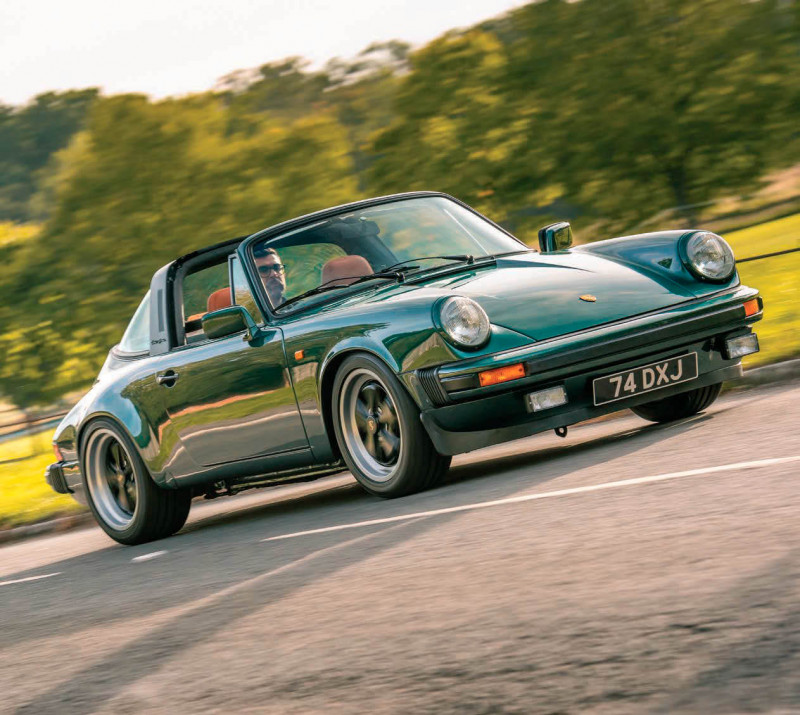
Above Rebuilt with just enough mod-cons to make driving the classic 911 a totally viable proposition for everyday travel
TORQUE MIGHT BE MODEST, BUT IT’S JUST WHERE YOU WANT IT STRONG, FROM 4,000RPM, CLIMBING TO NEAR 6,000RPM
Most specialists will farm at least two or three of these jobs out to the world beyond their workshop. And yes, they will nearly always be tried, tested and trusted third-parties, but when part of a project is in another company’s hands, it becomes hostage to the supply chain. How many times has a restoration been held up by work being carried out elsewhere?
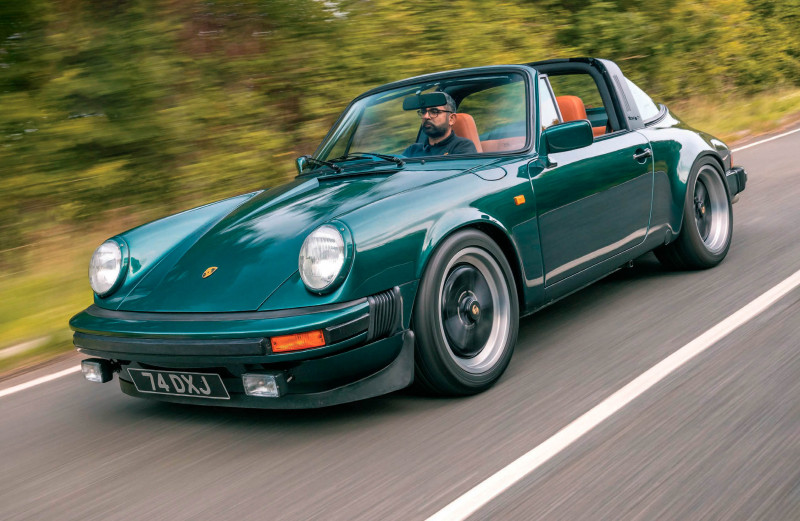
Above Subtle body changes, bigger wheels and lowered ride height work with the bespoke green to deliver a Targa with real road presence.
Of course, there are good reasons for most specialists to outsource. As Rindt’s man at the top, ex-professional golfer, Brian Richardson, succinctly puts it, “It’s expensive to do everything in-house, but equally, it’s a massive advantage, too.” Expensive? Well, all that expert talent and craftsmanship doesn’t come cheap, nor does the space to accommodate what is effectively an artisanal production line, albeit a very slow moving one.
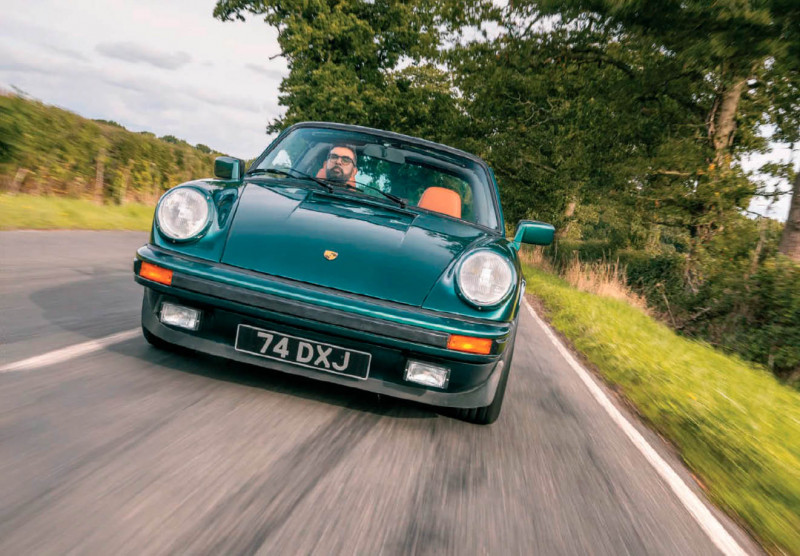
Above The body spent a full year in Rindt’s metalwork department, such was the derelict nature of the Targa when the project started.
Rindt Vehicle Design’s complex of rustic farm buildings — a stone’s throw from Windsor — looks every inch the Porsche resto equivalent of TV’s Repair Shop. The vibe inside is rather similar, too. Beneath the vast oak beams and vaulted ceilings, there is an atmosphere of calm, methodical endeavour, where Porsches are created or brought back to life.
THE 2.7-LITRE FLAT-SIX MIGHT NOT HAVE BEEN APPRECIATED IN PERIOD, BUT PAST GRIPES WEREN’T GOING TO STOP RINDT
By far the largest area is that of build, where painted bodies wait to be fitted out, the necessary components stacked neatly by each shell. Beyond are two ramps for the heavy lifting of engine and running gear installation. It’s an impressive space. Turn right and engines are being built. It’s hard to ignore a twin-turbocharged air-cooled flat-six (being prepared for an all-out build) situated alongside a rather more standard-issue boxer.
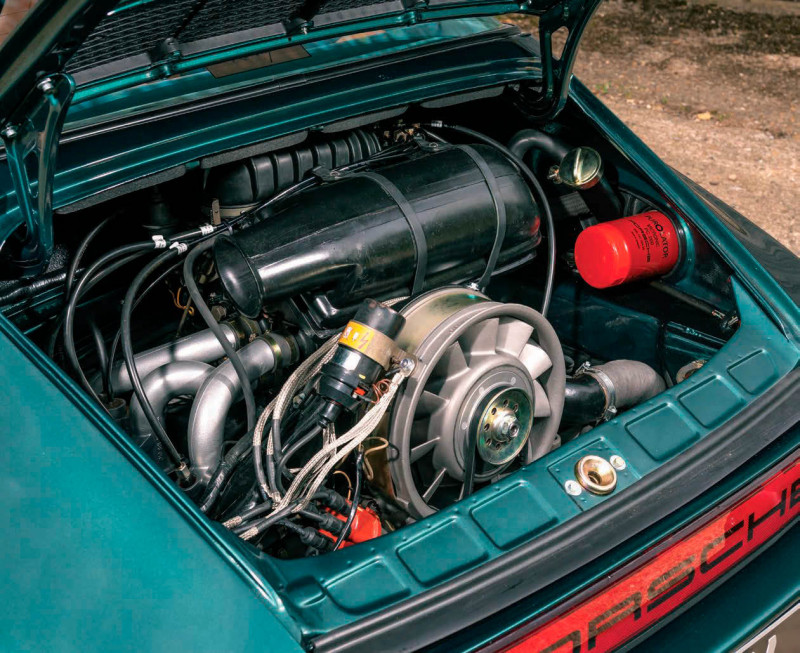
Above 2.7-litre flat-six has been fully rebuilt and, according to Rindt, has gained fifteen ponies in the process.
Perhaps the biggest “massive advantage” Rindt has is its dedicated trimming department, where sewing machines clatter and leather and cloth are cut to create bespoke or factory specification interiors. Indeed, interior trim is very often what finishes a project and it’s where an owner can exercise creative flair, certainly in terms of colours and materials. Likewise, the modernising touches which make a restomod day-today usable, such as a decent sound system and the connectivity required for retro-modern life.
Below Did you really expect anything other than a MOMO Prototipo steering wheel?!
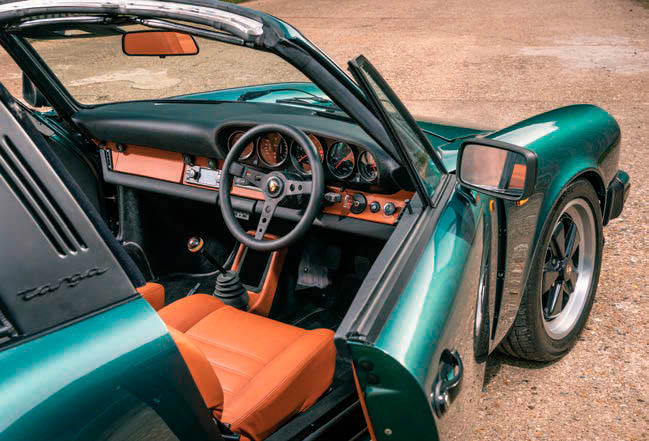
Sizeable as Rindt’s rural premises is, there’s no room for the body and paint shop, which occupies two units a mile or so down the road. Again, here, it’s hard not to be impressed at the scale of the operation, with no less than three Celette jigs and pegs to ensure factory tolerances for all bodyshell work. And there’s plenty of Porsche carcasses in the works, some in generally fine fettle, others, er, not quite so. But not to worry, it takes something truly shocking these days to render a classic Porsche beyond repair, and Rindt’s team have all the skills required. That said, it’s not unusual for a body to spend up to three months on a jig (or more, as we’ll find out) before painting. Talking of which, Rindt is well versed in Porsche’s vast colour palette and how to replicate the look and finish of the earlier paints used.
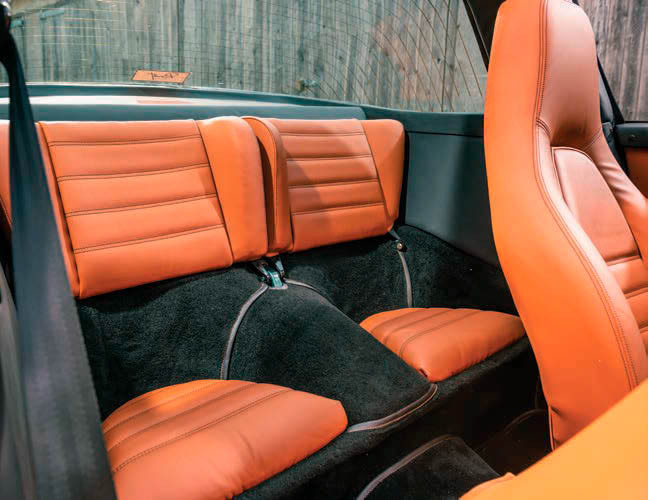
Tour over, it’s clear we will be back again in the not-too-distant future, such is the abundance of air-cooled 911s in build. For today, Brian and right-hand man, Trevor Ward, have rolled out a couple of corkers to be driven and appraised. We’ll keep the stunning restomod for our next issue. Suffice to say, it will be worth the wait. Instead, we’ll go with something which is, perhaps, the very definition of ‘less is more’. An interesting curio even, and not the most obvious starting point for a project.
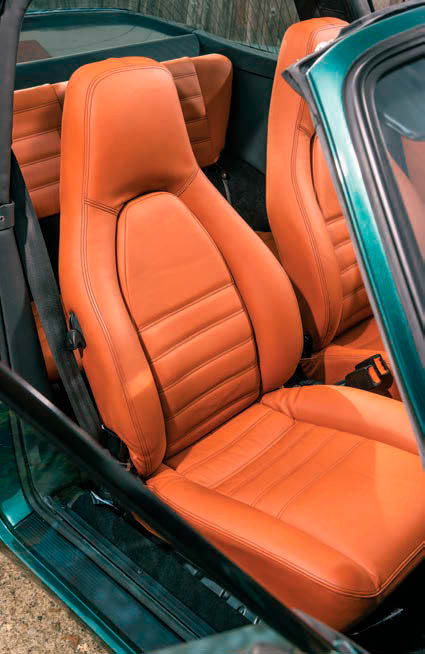
Above Brandy-coloured leather is the perfect match for the green paintwork
First impressions? No prizes for spotting It’s a G-series 911. The impact bumpers do rather give away the car’s identity, but here’s the thing: instead of car, owner and restorer automatically going down the backdate route, those tell-tale G-series traits have been retained and incorporated, while the sills have been removed for slight hint of retro. You’re probably thinking we’re in the presence of a 911 SC Targa dressed in an interesting shade of green. But, no, that wouldn’t be the ‘interesting curio’ to which we refer.
Below Porsche Classic Communication Management brings Apple CarPlay into the classic 911’s cabin.
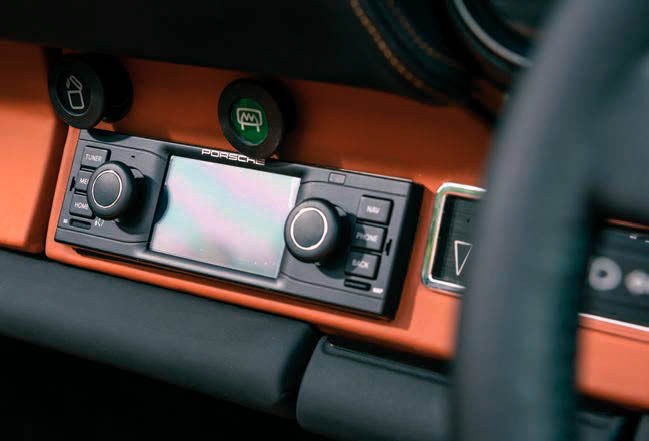
The basis for this project is actually a narrow-body 2.7-litre 911 of 1974 vintage, that slightly odd period when the G-series cars were finding their feet and Porsche felt the 911 needed a four-car line-up: Coupe, S, Carrera and Turbo. It’s probably fair to say the base 911 didn’t rock the impact bumper look quite as well as the wider body cars. It didn’t help, either, that it retained the chrome window trims of the pre-1974 cars, which didn’t work against the modern-looking, black bellows, black rubber bumper trim and overriders. The S, Carrera and, of course, the Turbo all sported a more modernising black window trim and wider, blackcentred, sixteen-inch Fuchs wheels, while the base 911 again looked rather quaint on narrow fifteens (or the never especially loved ‘cookie cutter’ style).

Above The G-series 2.7 isn’t the most loved of Porsche flat-sixes, but delivers more than enough poke when you hit 4,000rpm.
G-series 911s weren’t all about the imposition of the safety mandated bodywork, required for the US market. That same all-important market also demanded a clean-up of engine emissions. The big story, then, was the arrival of Bosch K-Jetronic fuel injection, with its precise and continuous fuel metering. This had absolutely the desired effect on both emissions and economy, particularly in the US, where catalytic converters were a legal requirement. Not so good for power, though — US-spec 911s lagged behind their European counterparts, not helped by weaker-than-Budweiser 91 octane fuel.
In Europe and beyond, K-Jetronic delivered a double — or even triple — whammy of improved performance, economy/emissions and drivability. The base 2.7 of 1974 had a 150bhp kick in the tail, up 20bhp on the preceding 1973 911 T, rising to 165bhp by 1976.
Not that it made any difference to sales. The base 2.7 just didn’t capture the imagination of the 911 crowd, which would thoroughly buy into the three-litre, wide-body cars. Unsurprisingly, the 2.7 and narrow-body style was dropped in 1976, when the 911 range was slimmed to two models: Carrera and Turbo. Excuse the brief diversion, but what the above means is that the 2.7 fell rapidly down the 911 food chain. Many of these cars were culled or simply run into the ground, which is a shame, because the 2.7 is still a 911, after all. Moreover, this particular Porsche has a charm all of its own. And if there is a budget/entry-level G-series 911, then the 2.7 is it, providing you can find one. All of which hopefully justifies our assertion of the 2.7’s ‘interesting curio’ status and thus prime candidacy for an interesting project. A blank canvas, even. Typically, this build was very much a collaboration between owner and restorer.
Brian describes the unloved 2.7 Targa starting point as a “scrapper”, which hadn’t been driven for twenty-odd years. “It was in a terrible state,” he says. “The early G-series 911s seem to be more prone to rot, but ultimately, there is no Porsche which can’t be saved.

This one spent twelve months on the body jig. It may not make economic sense, but then very few restorations do. Projects like this are very much a personal expression. You can’t really put a price on that.”
While it was tempting to retain the original narrowbody look, doing so would have meant almost certainly a restoration back to standard specification, or perhaps a mild hot rod vibe. More obvious was to go wide, just as the contemporary customer base did. It’s deceptive, but the arches have been re-worked to make them slightly wider than stock. Equally deceptive are the wheels. They look pretty much standard, but are, in fact, eighteeninchers, hence the need for a more accommodating arch, perfectly filled. The subtle metallic green paintwork is to Rindt’s own recipe and looks stunning, splendidly offsetting the black trim and the black Targa roll hoop. The devil is in the detail, they say — the same green has been used to detail the bonnet badge and crested centre caps. Needless to say, the Targa roof has been fully restored and, though we didn’t try it on the move, it fits good and tight.
G-SERIES 911S WEREN’T ALL ABOUT THE IMPOSITION OF THE SAFETY MANDATED BODYWORK, REQUIRED FOR THE US MARKET
After emerging from a year of body-build and paintwork, the shell then made the short journey to Rindt’s main assembly workshops to be united with running gear and interior. As you can probably guess, the entire car was subjected to the full ‘nut and bolt’ treatment, although not a great deal of the original “scrapper” remained, save for some suspension arms and casings, all of which were vapour blasted and zinc-plated where necessary or appropriate. The stance is achieved on stock Bilstein dampers, with re-set and lowered torsion bars, but more on this in our driving impressions.
The 2.7-litre flat-six might not have been appreciated in period, but past gripes weren’t going to stop the Rindt engine shop devoting 120 hours to this unit’s rebuild. Cue new pistons, barrels, connecting rods and a totally de-bugged and overhauled K-Jet system, which is key to getting one of these early injection engines running tickety-boo. Why not go for something more radical, or capacity enhanced? Well, despite the 165bhp donkey not being one of Porsche’s better-known powerplants, it is the heart and soul of this build and, let’s be honest, not every classic 911 has to be chucking out 300+bhp. Besides, thanks to attention to detail and build tolerances, Brian reckons an extra 15bhp has been extracted. 180bhp is not to be sniffed at, especially when a standard 911 Targa of this vintage weighs in at just 1,120kg. The rebuilt 2.7 is bolted to the back of an equally fully rebuilt Type 915 transaxle. Done properly, these sometimes unloved and underrated gearboxes have a shift and a character all of their own. We’ll find out soon enough.
DRINKING IT IN
Beforehand, it’s time to get comfortable. If the exterior look is subtle, then the interior is equally so. The brandyhued hide complements the custom metallic green and is ‘detailed’ with contrasting black stitching. And rather like a bodyshell can be de-seamed, the seats have been de-piped. The brandy theme extends to the custom door cards, which also feature a lightweight leather door pull and aluminium window winders. Also, check out the laser-cut, patterned speaker holes.
The dash top has been restored and trimmed in leather within a contrasting brandy stitch. The dials are particularly neat touch. They’re standard, save for the machine-polished rim to each bezel, for just a hint of bling in an otherwise tastefully sober cabin. Finishing touches? A MOMO Prototipo steering wheel (obviously), plus a Rindt-branded milled wooden gear knob, handy USB ports and a Porsche Classic Communication Management (PCCM) head unit, allowing Apple CarPlay to bring a touch of the future to the past.
BRIAN DESCRIBES THE UNLOVED 2.7 TARGA STARTING POINT AS A “SCRAPPER”, WHICH HADN’T BEEN DRIVEN FOR TWENTY-ODD YEARS
Time for a drive, which means less of the collective Classic Porsche ‘we’ and more of the personal ‘me’. I’m the one in the hot seat, after all. I’m reverting to the first person because I have, on occasion, been somewhat scathing of the Targa concept, although not nearly as scathing as I have about the 911 Cabriolet. But like so many things in life, they start to make sense as you grow up a bit and the penny drops that not every 911 has to be a hardcore road racer, despite the fact the Targa is named after one. Sometimes it’s okay to drift a little, a light breeze around the barnet, sun on your head, the sound of a flat-six in your slipstream. That’s exactly what the Targa is all about. It’s exactly what this build is all about, too.
Below Classic 911 Targa remains one of the most affordable routes into aircooled Porsche ownership.
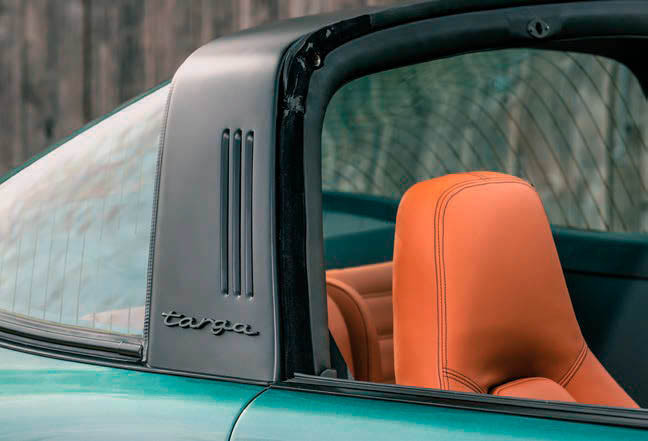
Quite simply, this is a lovely Porsche to drive. It fizzes with 911 character and feedback. That careful build and matching of components is rewarded by an engine feeling instantly responsive to the throttle, revving smoothly and seemingly lacking in inertia. Torque might be modest, but it’s just where you want it strong, from 4,000rpm, climbing to near a 6,000rpm redline when the mood suits. It’s all usable, which is the best thing about the 2.7 — you can make it sing and use everything on offer, but in a way that doesn’t attract attention. The 915 ‘box, since it’s been mentioned in despatches?
It’s as good as they get. Never a ratio-swapper to be rushed, it rewards a methodical approach and definite pause in the neutral plane, before gently easing the shifter into the next gear. Typically, you shift with your shoulder, such is the range of the lever. It’s all part of the 911’s character.
I confess, I wasn’t sure about eighteen-inch wheels on a 911 of this vintage, but in truth, they work just fine. Better than fine, because you wouldn’t know they were so big. The steering is still delicate, and no heavier than standard. The Michelin Pilot Sports accurately read the road, transmitting detailed feedback. And the ride? I was keen to experience this, having run my own Carrera 3.2 on Turbo Fuchs with lowered torsion bars and standard dampers. I always thought it was a well-suited set-up for British roads, whether by luck or design.
Whatever, here again, I wondered whether eighteens and a low profile would have an impact, but no. Compared to a lowered spring, a lowered torsion bar always seems to retain more of its original compliance and allows the damper its full range. I confess, I probably spent rather more time driving this fabulous 911 around Rindt’s base than I should have, finding excuses to explore a criss-cross of B-roads that were doing a good job of debunking the theory the South East of England is a grid-locked nightmare.
Admittedly, the classic Targa’s snake-hipped dimensions were rather more suited to the terrain than, say, a contemporary 911. Isn’t this part of the appeal? Our rural roads have remained the same, it’s us that’s got bigger.
Eventually, I did find my way back. As I alluded to earlier, there was, after all, another Rindt build to be driven. A bruiser, in fact. The complete antithesis to this delicate Targa. I dare say there will be more to sample thereafter. For now, however, let’s applaud Rindt and this 911’s visionary owner for taking a derelict Porsche and turning it into something slightly more leftfield than your typical restomod build. If you want something similar, then you know who you should be talking to.


